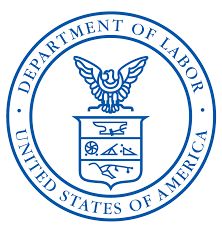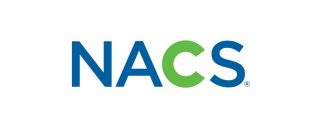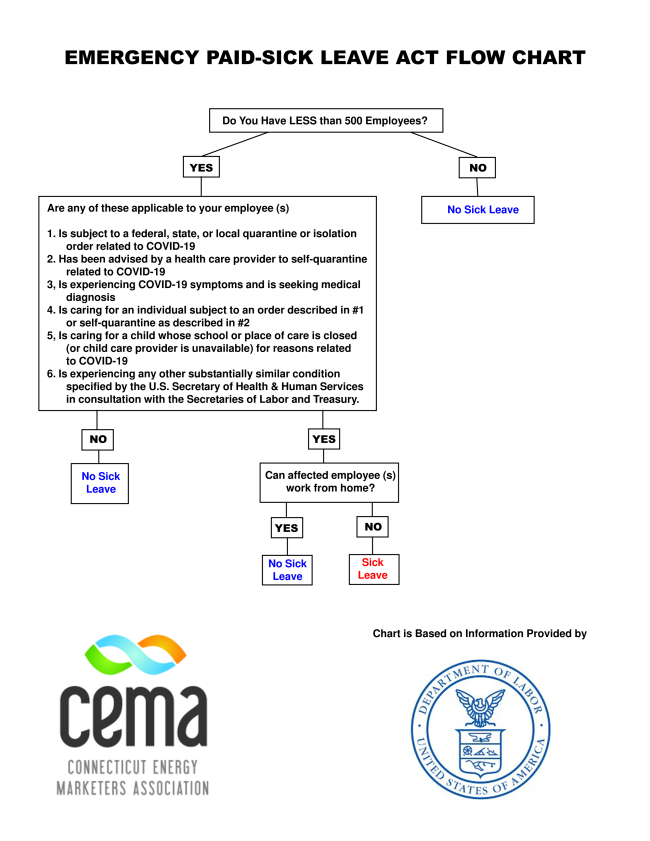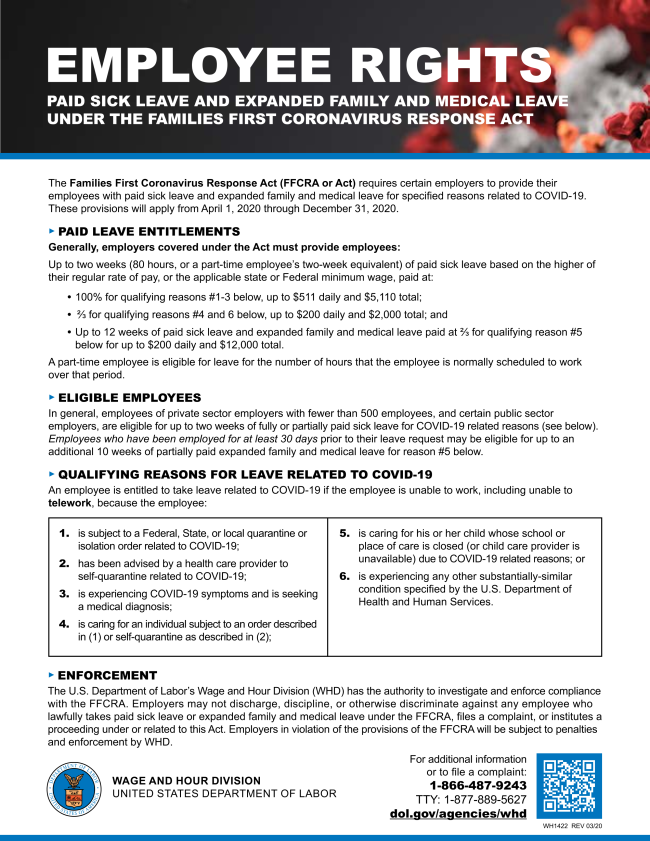 The Families First Coronavirus Response Act (FFCRA) that we reported on earlier now goes into effect on Wednesday, April 1 according to the U.S. Department of Labor’s website here. There is also a component of family leave to care for a child whose school has closed, which is structured differently than paid sick leave, and is also covered below.
The Families First Coronavirus Response Act (FFCRA) that we reported on earlier now goes into effect on Wednesday, April 1 according to the U.S. Department of Labor’s website here. There is also a component of family leave to care for a child whose school has closed, which is structured differently than paid sick leave, and is also covered below.
The law is complex and fully explained below – but here it is in a nutshell. All employers with fewer than 500 employees must pay paid sick leave to certain eligible employees, as detailed below, for up to 2 weeks (full or 2/3rds pay depending on the situation), plus up to another 10 weeks to care for a child whose school has closed. But the paid leave only applies if the employee can’t work from home. The employer gets tax credits for all paid leave payments by reducing their quarterly/monthly payroll tax submissions to the IRS.
UPDATE 2: The U.S. Department of Labor just published new Q&A for the paid sick leave law. There are 37 comprehensive Q&A which can be viewed HERE. Guidance below has been revised, where applicable, in accordance with this new DOL information.
The most important change is that a state ordering non-essential businesses to shut down does not in itself trigger paid leave. Only the 6 events listed below trigger paid leave, e.g. government orders to employees to quarantine or self-isolate, child care, etc. and only then if the employee can’t telework from home.
Since gas stations and heating fuel/HVAC companies are deemed essential by Connecticut at this time, this rule does not have a practical effect on our industry compared to our prior guidance, since they have not been shut down. Some non-essential associate members that have shut down, however, now no longer have to provide leave just because they are shut down. One of the six qualifying events below would still have to be applicable.
Generally, the Act provides that covered employers must provide to all employees:
- Two weeks (up to 80 hours) of paid sick leave at the employee’s regular rate of pay where the employee is unable to work because the employee is quarantined (pursuant to Federal, State, or local government order or advice of a health care provider), and/or experiencing COVID-19 symptoms and seeking a medical diagnosis; or
- Two weeks (up to 80 hours) of paid sick leave at two-thirds the employee’s regular rate of pay because the employee is unable to work because of a bona fide need to care for an individual subject to quarantine (pursuant to Federal, State, or local government order or advice of a health care provider), or care for a child (under 18 years of age) whose school or child care provider is closed or unavailable for reasons related to COVID-19, and/or the employee is experiencing a substantially similar condition as specified by the Secretary of Health and Human Services, in consultation with the Secretaries of the Treasury and Labor.
A covered employer must provide to employees that it has employed for at least 30 days:
- Up to an additional 10 weeks of paid expanded family and medical leave at two-thirds the employee’s regular rate of pay where an employee is unable to work due to a bona fide need for leave to care for a child whose school or child care provider is closed or unavailable for reasons related to COVID-19.
Covered Employers: The paid sick leave and expanded family and medical leave provisions of the FFCRA apply to certain public employers, and private employers with fewer than 500 employees.Small businesses with fewer than 50 employees may qualify for exemption from the requirement to provide leave due to school closings or child care unavailability if the leave requirements would jeopardize the viability of the business as a going concern.
Qualifying Reasons for Leave:
Under the FFCRA, an employee qualifies for paid sick time if the employee is unable to work (or unable to telework) due to a need for leave because the employee:
- is subject to a Federal, State, or local quarantine or isolation order related to COVID-19;
- has been advised by a health care provider to self-quarantine related to COVID-19;
- is experiencing COVID-19 symptoms and is seeking a medical diagnosis;
- is caring for an individual subject to an order described in (1) or self-quarantine as described in (2);
- is caring for a child whose school or place of care is closed (or child care provider is unavailable) for reasons related to COVID-19; or
- is experiencing any other substantially-similar condition specified by the Secretary of Health and Human Services, in consultation with the Secretaries of Labor and Treasury.
Duration of Leave:
For reasons (1)-(4) and (6): A full-time employee is eligible for up to 80 hours of leave, and a part-time employee is eligible for the number of hours of leave that the employee works on average over a two-week period.
For reason (5) – child care: A full-time employee is eligible for up to 12 weeks of leave at 40 hours a week (inclusive of the two weeks of paid sick leave), and a part-time employee is eligible for leave for the number of hours that the employee is normally scheduled to work over that period.
Calculation of Pay:
For leave reasons (1), (2), or (3): employees taking leave shall be paid at either their regular rate or the applicable minimum wage, whichever is higher, up to $511 per day and $5,110 in the aggregate (over a 2-week period).
For leave reasons (4) or (6): employees taking leave shall be paid at 2/3 their regular rate or 2/3 the applicable minimum wage, whichever is higher, up to $200 per day and $2,000 in the aggregate (over a 2-week period).
For leave reason (5) – child care: employees taking leave shall be paid at 2/3 their regular rate or 2/3 the applicable minimum wage, whichever is higher, up to $200 per day and $12,000 in the aggregate (over a 12-week period—two weeks of paid sick leave followed by up to 10 weeks of paid expanded family and medical leave). Note in this case where you’re caring for a child whose school is closed, you get 2 weeks of regular paid sick leave, then 10 weeks of child care leave at 2/3rds pay.
NOTE: in all cases, paid sick leave only applies if the employee is unable to “telework” from home.
Tax Credits: Covered employers qualify for dollar-for-dollar reimbursement through tax credits for all qualifying wages paid under the FFCRA. Qualifying wages are those paid to an employee who takes leave under the Act for a qualifying reason, up to the appropriate per diem and aggregate payment caps. Applicable tax credits also extend to amounts paid or incurred to maintain health insurance coverage. As explained here, you can deduct FFCRA payments from your tax payments to the IRS as explained below and here.
When employers pay their employees, they are required to withhold from their employees’ paychecks federal income taxes and the employees’ share of Social Security and Medicare taxes. The employers then are required to deposit these federal taxes, along with their share of Social Security and Medicare taxes, with the IRS and file quarterly payroll tax returns (Form 941 series) with the IRS.
Under guidance that will be released next week, eligible employers who pay qualifying sick or child-care leave will be able to retain an amount of the payroll taxes equal to the amount of qualifying sick and child-care leave that they paid, rather than deposit them with the IRS.
The payroll taxes that are available for retention include withheld federal income taxes, the employee share of Social Security and Medicare taxes and the employer share of Social Security and Medicare taxes with respect to all employees.
If there are not sufficient payroll taxes to cover the cost of qualified sick and child care leave paid, employers will be able file a request for an accelerated payment from the IRS. The IRS expects to process these requests in two weeks or less. The details of this new, expedited procedure will be announced next week.
Employer Notice: Each covered employer must post in a conspicuous place on its premises a notice of FFCRA requirements (see below)
Prohibitions: Employers may not discharge, discipline, or otherwise discriminate against any employee who takes paid sick leave under the FFCRA and files a complaint or institutes a proceeding under or related to the FFCRA.
CEMA’s Flow Chart
Now figuring out if paid sick leave applies or not may look daunting, which is why we created this handy flow chart showing when sick leave is applicable or not.
Note this chart has been edited from an earlier version in accordance with new guidance by the U.S. Department of Labor which says shutting down non-essential businesses is not a trigger for paid leave. As the chart shows, one of six other triggers have to apply.
Just click on the diagram to the left to download a full-page .pdf of the flow chart.
Employee Rights Poster
As an employer, you must inform employees of their paid leave rights.
You can do so by downloading the poster shown to the left and showing it to them, or going here.
NACS Q&A
 Earlier this week, NACS, The National Association of Convenience Stores, held an informative webinar on the new paid family leave law. Though put on by the convenience store association, their guidance is applicable to all small businesses and their webinar can be viewed here. The following is additional Q&A not addressed during the webinar.
Earlier this week, NACS, The National Association of Convenience Stores, held an informative webinar on the new paid family leave law. Though put on by the convenience store association, their guidance is applicable to all small businesses and their webinar can be viewed here. The following is additional Q&A not addressed during the webinar.
Q1: If my employer closed my worksite before April 1, 2020 (the effective date of the FFCRA), can I still get paid sick leave or expanded family and medical leave?
A1: No. If, prior to the FFCRA’s effective date, your employer sent you home and stops paying you because it does not have work for you to do, you will not get paid sick leave or expanded family and medical leave but you may be eligible for unemployment insurance benefits. This is true whether your employer closes your worksite for lack of business or because it is required to close pursuant to a Federal, State, or local directive. This per DOL Q&A here.
Q2: If my employer closes my worksite on or after April 1, 2020 (the effective date of the FFCRA), but before I go out on leave, can I still get paid sick leave and/or expanded family and medical leave?
A2: No. If your employer closes after the FFCRA’s effective date (even if you requested leave prior to the closure), you will not get paid sick leave or expanded family and medical leave but you may be eligible for unemployment insurance benefits. This is true whether your employer closes your worksite for lack of business or because it was required to close pursuant to a Federal, State or local directive. This per DOL Q&A here.
Q3: If my employer closes my worksite while I am on paid sick leave or expanded family and medical leave, what happens?
A3: If your employer closes while you are on paid sick leave or expanded family and medical leave, your employer must pay for any paid sick leave or expanded family and medical leave you used before the employer closed. As of the date your employer closes your worksite, you are no longer entitled to paid sick leave or expanded family and medical leave, but you may be eligible for unemployment insurance benefits. This is true whether your employer closes your worksite for lack of business or because the employer was required to close pursuant to a Federal, State or local directive.This per DOL Q&A here.
Q4: Are there industry exemptions to the paid leave law other than healthcare workers and first-responders?
A4: No, but the Secretary of Labor has authority on good cause shown to exempt small businesses (with fewer than 50 employees) from the child care provisions to the extent that viability of the business as an ongoing concern.
Q5: If an employee quits or is let go prior to April 1 is the business required to provide these benefits
A5: It may depend on why the employee was let go. An employee who quits is not entitled to the benefit. If, however, they were let go for a qualifying reason (such as being diagnosed for COVID-19 in which no telework is available), then to the extent those conditions remain on April 1st, their benefits eligibility would commence and continue thereafter.
Q6: Can an employer require documentation for sick leave to qualify?
A6: They may ask for such documentation, but under the present circumstances it is not realistic to expect it in the short term, and health care providers are currently being overwhelmed by more pressing matters. Consequently, paid leave benefits should not be denied on that basis alone.
Q7: If an employee has no regular paid time off available do we pay them for the first 10 days of EFMLA child care leave?
A7: No, but if the employee has no regular leave available they may choose to apply the emergency sick leave to the first 10 days of EFMLA leave, meaning you would either pay them at their full rate or 2/3 rate for those 10 days depending on the category they fall into. You would then pay them at 2/3 rate for the remaining EFMLA time. If the employee chooses not to apply the emergency sick leave time and preserve it then they may go unpaid for the first 10 days.
Q8: Must an employee be actually diagnosed with covid-19 to qualify for emergency sick leave?
A8: No, if they are experiencing symptoms and seeking a medical diagnosis or have been advised by a medical professional to isolate, they still qualify. If they are ultimately confirmed to have something else such as the flu, additional time off after confirmation that their symptoms are not related to COVID-19 would not be covered.
Q9: If an employee is over 65 and the Governor has told everyone over 65 to please stay home do they qualify?
A9: Not unless they otherwise satisfy one of the qualifying reasons or have been specifically advised by a heath care provider to self-quarantine due to COVID-19 concerns. Also if this order from the Governor is mandatory enforceable by law, as opposed to just a recommendation, then yes, that triggers the first case, which is where the employee is subject to mandatory self-isolation.
Q10: Do these rules apply to exempt salaried employees also?
A10: Yes.
Q11: If an employee is currently off of work to take care of a child whose school has closed, do they become eligible for the FMLA pay on April 1?
A11: Yes as long as they are unable to work from home.
Q12: If an employee takes emergency paid sick leave for one of qualifying reasons 4 -6 for 5 days but then becomes sick themselves must we change their pay for the remaining 5 days to 100%?
A12: Yes.
Q13: If an employee is out now and returns before April 1, are they still eligible for the emergency sick leave?
A13: Not unless they subsequently take leave for a qualifying reason on or after April 1.
Q14: Must all of the paid sick days be used consecutively?
A14: No.
Q15: Does the emergency paid time off apply to businesses that do no currently offer benefits?
A15: Yes, the emergency paid leave provisions apply to any employer with 500 or fewer employees regardless of what benefits they currently offer.
Q16: What steps can be taken to prevent employees from taking advantage of paid time off if they don’t actually qualify?
A16: The most effective step is to develop a thorough understanding of the parameters surrounding the six qualifying reasons, and to strictly hold employees accountable for establishing eligibility within the bounds of the law – taking into account the practical challenges under the current environment.
Q17: If an employee took regular FMLA time within the past 12 months and has returned, are they now eligible for another 12 weeks of EFMLA time as well?
A17: Subject to confirmation from clarifying regulations that have yet to be issued, we believe the intent of EFMLA was to serve as an expansion of existing reasons for FMLA leave – but not of the amount of cumulative FMLA leave that can be taken in any 12-month period. Consequently, Yes, EFMLA leave taken should be counted against an employee’s annualized entitlement, such that they would not be permitted to exhaust their FMLA leave for other reasons, only to take an additional 12 weeks of EFMLA leave.
Q18: How do you calculate rate of pay for an employee how works on commission only?
A18: Regardless of whether earnings occur on an hourly, piece-rate, salary or commission basis, the regular rate is computed on the basis of the average rate derived from such earnings for the particular workweek. The formula consists of total compensation in the workweek (except for statutory exclusions) ÷ total hours worked in the workweek = regular rate for the workweek.


